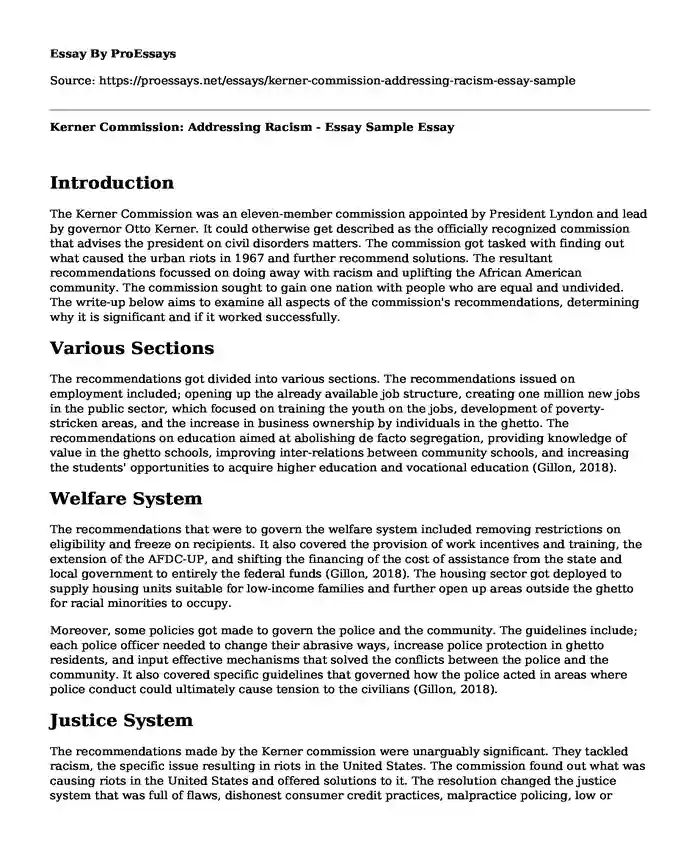Introduction
The Kerner Commission was an eleven-member commission appointed by President Lyndon and lead by governor Otto Kerner. It could otherwise get described as the officially recognized commission that advises the president on civil disorders matters. The commission got tasked with finding out what caused the urban riots in 1967 and further recommend solutions. The resultant recommendations focussed on doing away with racism and uplifting the African American community. The commission sought to gain one nation with people who are equal and undivided. The write-up below aims to examine all aspects of the commission's recommendations, determining why it is significant and if it worked successfully.
Various Sections
The recommendations got divided into various sections. The recommendations issued on employment included; opening up the already available job structure, creating one million new jobs in the public sector, which focused on training the youth on the jobs, development of poverty-stricken areas, and the increase in business ownership by individuals in the ghetto. The recommendations on education aimed at abolishing de facto segregation, providing knowledge of value in the ghetto schools, improving inter-relations between community schools, and increasing the students' opportunities to acquire higher education and vocational education (Gillon, 2018).
Welfare System
The recommendations that were to govern the welfare system included removing restrictions on eligibility and freeze on recipients. It also covered the provision of work incentives and training, the extension of the AFDC-UP, and shifting the financing of the cost of assistance from the state and local government to entirely the federal funds (Gillon, 2018). The housing sector got deployed to supply housing units suitable for low-income families and further open up areas outside the ghetto for racial minorities to occupy.
Moreover, some policies got made to govern the police and the community. The guidelines include; each police officer needed to change their abrasive ways, increase police protection in ghetto residents, and input effective mechanisms that solved the conflicts between the police and the community. It also covered specific guidelines that governed how the police acted in areas where police conduct could ultimately cause tension to the civilians (Gillon, 2018).
Justice System
The recommendations made by the Kerner commission were unarguably significant. They tackled racism, the specific issue resulting in riots in the United States. The commission found out what was causing riots in the United States and offered solutions to it. The resolution changed the justice system that was full of flaws, dishonest consumer credit practices, malpractice policing, low or insufficient housing, high unemployment of African American individuals, the dominance of voters, and other types of racial discrimination that were culturally-rooted (Loessberg & Koskinen, 2018). It protected each member of society, thus preventing the nation's division into two different groups.
In the beginning, the recommendations got criticized, and it seemed like it would be impossible to implement them, but with time its work started bearing fruits. Neighborhoods started diversifying, which meant that African Americans could attend schools in these areas and could also acquire jobs without discrimination (Loessberg & Koskinen, 2018). It further opened up voting, which increased the number of minority representatives in the government. An effort got made to improve the housing conditions and the state of the schools that functioned in minority neighborhoods.
Conclusion
In conclusion, the recommendations made by the Kerner commission were important. They governed the society, in general, to prevent the division of the nation into two. They also gave hope of a better future to the minority groups who were fearful—the recommendation covered sectors such as education, housing, security, welfare, and employment. Over the years, it is evident that the solutions have been beneficial in integrating minority groups into society. Racial discrimination is currently not curbed completely, but it has been reduced substantially.
References
Gillon, S. M. (2018). Separate and unequal: The Kerner Commission and the unravelling of American liberalism. Basic Books.
Loessberg, R., & Koskinen, J. (2018). Measuring the distance: The legacy of the Kerner report. RSF: The Russell Sage Foundation Journal of the Social Sciences, 4(6), 99-119.
Cite this page
Kerner Commission: Addressing Racism - Essay Sample. (2023, Nov 16). Retrieved from https://proessays.net/essays/kerner-commission-addressing-racism-essay-sample
If you are the original author of this essay and no longer wish to have it published on the ProEssays website, please click below to request its removal:
- Essay Sample on Ways to Prevent the Terrorist Act: Psycho-Social Transition Model
- Essay Example on Juvenile Crime: The Urgent Need for More Prisons
- Essay Sample on Racism in Human Society: Orelu's Prioritization of Meaningful Factors
- Paper Example on Politics of Immigration: Debates & Downsides
- Gang-Influenced Drug Abuse, Crime, and Violence - Essay Sample
- Essay Example on Prescription Opioids and Their Unexpected Effects: A Reality Check
- Paper Example on National Immigration Policy: Who Should Regulate?







